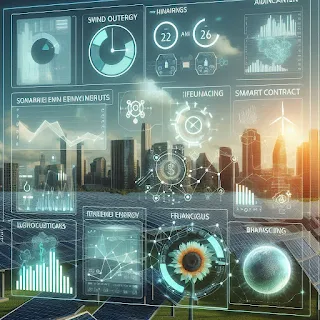The transition to renewable energy is critical for achieving global net-zero goals. However, financing remains a significant barrier, especially in emerging economies. Enter Artificial Intelligence (AI) and Financial Technology (Fintech)—two disruptive forces transforming how green projects are funded, monitored, and scaled. This article explores how AI and Fintech are revolutionizing renewable energy financing and making clean power more accessible, efficient, and scalable.
1. The Financing Gap in Renewable Energy
Why Financing Is a Barrier
Renewable projects often require significant upfront investments and long-term financial planning. Traditional financial institutions are hesitant to invest due to perceived risks, lack of credit history, and regulatory uncertainty.
Impact on Developing Economies
Countries in the Global South often lack robust financing ecosystems, leading to underinvestment in clean energy infrastructure despite immense potential.
2. Fintech’s Role in Democratizing Green Investment
Crowdfunding and Peer-to-Peer Platforms
Fintech platforms are enabling individuals to invest in renewable projects through micro-investments and community-based crowdfunding. This democratizes finance and diversifies funding sources.
Blockchain for Transparency and Trust
Blockchain ensures transparency in transactions, which builds trust among investors and stakeholders. It also facilitates real-time tracking of energy generation and consumption, especially in decentralized solar microgrids.
Smart Contracts in Green Finance
Smart contracts automate transactions, reducing overhead and increasing the efficiency of disbursing and managing green funds.
3. How AI Enhances Financing Efficiency
Risk Assessment and Credit Scoring
AI algorithms analyze massive datasets—weather patterns, historical project performance, market volatility—to assess project viability and creditworthiness far more accurately than traditional models.
Fraud Detection and Compliance
AI helps detect anomalies and ensures regulatory compliance, making investments more secure.
Predictive Analytics for Energy Generation
AI models predict the future energy output of a project, helping financiers evaluate return on investment (ROI) with greater precision.
4. Real-World Applications and Case Studies
Google’s AI for Energy Efficiency
Google DeepMind uses AI to manage data center cooling, saving energy and reducing costs—proving AI’s capability in optimizing energy systems.
WePower’s Tokenized Renewable Platform
Lithuania-based WePower uses blockchain and AI to allow investors to buy, sell, or trade renewable energy directly from producers.
India's UPI Model for Clean Energy Transactions
India’s Unified Payments Interface (UPI), though not specific to energy, showcases how digital financial infrastructure can accelerate investment in clean technologies when tailored appropriately.
5. The Road Ahead: Challenges and Opportunities
Data Privacy and Security
With the use of AI and blockchain comes the need to secure user data and maintain regulatory compliance.
Policy and Regulation
To scale AI and Fintech in green finance, policies must evolve to accommodate new financial instruments and technologies.
Skills and Infrastructure
Developing nations must invest in digital literacy and infrastructure to leverage these technologies fully.
Conclusion
AI and Fintech are not just buzzwords—they are the catalysts driving the next wave of renewable energy financing. By enhancing transparency, improving efficiency, and democratizing access, these technologies can help close the green funding gap and accelerate the global energy transition. Governments, investors, and tech innovators must work together to harness this powerful synergy for a sustainable future.


No comments:
Post a Comment